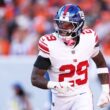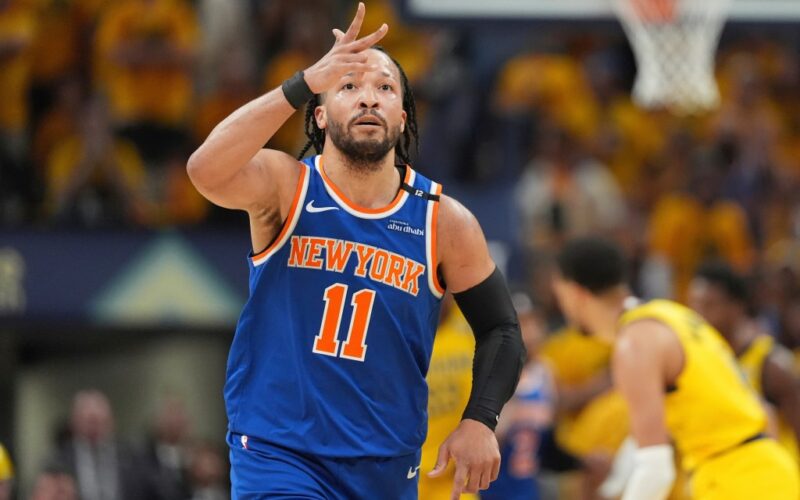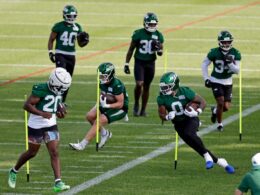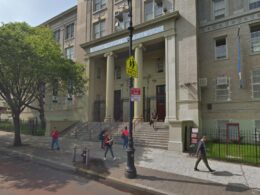The United States flag hangs in the northeastern corner of the Knicks’ practice facility in Tarrytown. To its left, running horizontally across the wall, two banners read 1969-70 and 1972-73 — the last time the Knicks were kings of basketball.
Stretching further left, separated by a long white beam, are the retired numbers of the men who helped hang them: 613 for head coach Red Holzman, 33 for Patrick Ewing — seated courtside on the first day of camp — 22 for Bill Bradley, 24 for Dave DeBusschere, 19 for Willis Reed, the twin 15s for Earl Monroe and Dick McGuire, 12 for Dick Barnett, and 10 for Walt “Clyde” Frazier.
It’s an everyday reminder of what hasn’t happened in more than fifty years — and everything that’s happened since.
For a quarter century, the Knicks have chased the echoes of those banners through every possible reinvention. From Ewing’s heartbreak and the ’99 Finals run to the chaos of the Isiah Thomas years, from Carmelo Anthony’s one-man era to Tom Thibodeau’s grinding resurgence, each generation has worn those ghosts like a weight.
Now, under Mike Brown, the franchise once again stands at a crossroads, this time with the clearest path in decades.
Jayson Tatum is out in Boston. Tyrese Haliburton is injured in Indiana. Damian Lillard is gone from Giannis Antetokounmpo’s orbit in Milwaukee. The Eastern Conference throne sits unguarded.
And if there’s ever been a moment for the Knicks to write their next banner onto that wall in Tarrytown, it’s now.
Because every era of Knicks basketball — from the heartbreaks to the rebuilds to the fleeting revivals — has led to this one.
* * *
The game Ewing is watching unfold before his eyes inside the Knicks’ Tarrytown fortress is unrecognizable compared to the one he dominated decades ago.
Brown preaches pace and space — getting to the paint, generating open threes, turning defense into transition. He believes speed forces mistakes and movement creates opportunity. Ewing ruled in a different time, when the paint was crowded, the elbows were sharp, and every basket felt like a fistfight won through attrition.
But no one understands the weight of expectations at Madison Square Garden better than Ewing. He carried them for fifteen years.
The 1998–99 Knicks were his final stand — the last great monument to the franchise’s blue-collar identity. They opened that lockout-shortened season fractured and uncertain: Ewing was aging, Latrell Sprewell was searching for redemption and Jeff Van Gundy was trying to bind chaos into chemistry. Yet somehow, the group willed its way into history, becoming the first No. 8 seed to reach the NBA Finals.
Their identity was unmistakable: bruises before beauty. Allan Houston’s mid-range precision, Marcus Camby’s wiry defense, Larry Johnson’s improbable four-point play — all products of grind and grit. They averaged just 91.8 points per game, shot under 44%, and made every possession a collision.
When Ewing tore his Achilles before the conference finals, Camby stepped in and the Knicks kept swinging, toppling Indiana before falling to Tim Duncan and the San Antonio Spurs in five.
That run marked the end of an era. The game has changed before Ewing’s eyes.
Brown’s Knicks may hunt pace and spacing now, but their roots trace back to a team that proved toughness could take you to the brink. The franchise’s modern reinvention still echoes the standard Ewing set.
The Knicks may start off slow as they adapt Brown’s new offensive and defensive philosophies, but they are aiming to play their best basketball when it matters most: at the end of the season, peaking into the playoffs with their eyes on the prize.
An NBA title.
* * *
Carmelo made it clear: he rose to fame at Syracuse, became a perennial All-Star in Denver, but when it comes time to walk into the Naismith Memorial Basketball Hall of Fame, there’s no debate.
Once a Knick, always a Knick.
His every courtside appearance at Madison Square Garden is a reminder of one of the most entertaining seasons in modern Knicks history — and a stark reflection of how long it’s been since the franchise reached those same heights.
In one magical year, Anthony captured the scoring title at 28.7 points per game, J.R. Smith claimed Sixth Man of the Year honors and the Knicks won 54 games — their most in 16 years — while finishing third in offensive efficiency.
They were stylish, confident and fun — a team New York could finally rally around again as Jason Kidd quarterbacked the offense, Tyson Chandler anchored the defense and Iman Shumpert brought youthful energy that fed into the Garden’s electricity.

That season, though, ended the same way too many Knicks seasons have: at the hands of the Indiana Pacers in a grinding second-round exit that’s now grown eerily familiar after back-to-back postseason losses to the same franchise.
Then came Phil Jackson, and with Jackson came chaos — coaching changes, power struggles and the slow unraveling of what little stability New York had reclaimed. Melo’s exit was abrupt, and the Knicks slipped into another spiral, one that would stretch into a seven-year playoff drought before Julius Randle, Jalen Brunson and Thibodeau dragged them back into contention.
* * *
One name is eerily missing from the street signs scattered across New York City.
The Knicks made the Eastern Conference Finals for the first time in a quarter-century, but it was only five short seasons ago that such a run felt like an impossible dream.
Thibodeau changed that. He coached the Knicks into a revival.
Thibodeau brought structure to chaos and a winning culture to a basketball mecca that had long forgotten what one felt like.
In short: Thibs gave New York its spark back.
Under Thibodeau, the Knicks evolved from perennial lottery participants to one of the East’s most consistent contenders. In 2021, he snapped a seven-year playoff drought, coaching Randle to Most Improved Player honors and restoring a defensive edge that mirrored the city’s grit.
Two years later, after the addition of Brunson, that foundation blossomed into something greater: back-to-back 50-win seasons, an Eastern Conference Finals berth, and street signs raised across the Mecca of Basketball in honor of the players who suited up for him.
Thibodeau exits New York as one of the most respected figures to hold the clipboard — a two-time Coach of the Year who compiled a 226-174 record over five seasons and helped elevate players like Brunson, Randle and Josh Hart to new heights.
His fingerprints remain everywhere — including on the doorknob at the exit of the Knicks’ practice facility in Tarrytown.
Despite his success, the Knicks parted ways with the coach who resurrected the franchise. In his place stands a new architect with lion-sized shoes to fill — and a plan to take New York somewhere Thibodeau never could: beyond the grind, and toward glory.
* * *
Brown is strolling the sidelines of the northernmost court inside the Knicks’ Tarrytown practice facility, directly opposite the wall adorned with the banners of team history. On the far end, a cluster of front-office executives watch from the southern wall: quiet, analytical, and observant.
As Brown strolls, his players sprint. This is the new Knicks way.
Brown is installing his West Coast-style run-and-gun offense in a building long defined by grit and grind. His philosophy — speed, spacing, selflessness and shot-making — is designed to take last year’s core and lift it beyond the structural ceiling that Thibodeau’s slower, more deliberate system imposed.
The roster has evolved to match the mission. Somewhat.
Guerschon Yabusele and Jordan Clarkson arrived as upgrades over Precious Achiuwa and Cameron Payne, infusing the bench with size and scoring punch. The staff believes Miles McBride can take another leap in Brown’s uptempo, pressure-heavy system — and that a deeper rotation can help preserve the legs of Brunson, Anunoby and Karl-Anthony Towns for the grind of another deep playoff run, even if it costs a few regular-season wins along the way.
Above it all, those championship banners hang as a silent reminder. A long, white vertical beam separates Walt Frazier’s No. 10 from the open space that remains blank, waiting for the next chapter.
Perhaps one day the Knicks will hang No. 7 for Carmelo Anthony, the 2025 Hall of Fame inductee who re-sparked belief at the Garden. But beyond that wall space, there’s still room — space for No. 13 and No. 32, for Brunson and Towns, should they lead the city to something greater.
And the recognition will stretch well beyond the team’s two captains. After all, the city put up street signs for a conference finals run.
If these Knicks deliver the franchise’s first championship in more than 50 years, they might create a different kind of problem: reorganizing the Tarrytown rafters to create room for every player who plays a hand in bringing the franchise a title.








